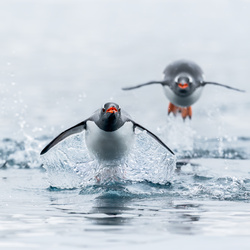this fly was sitting on a pink flower at the morning after a rainy night.
Stacking is fun!
And how do you manage to capture more than 50 shots of a fly in dewdrops without killing it? Read this ;)
I don't like killing animals, even if it is a fly. Specially for photography purpose I love the challenge to shoot living objects. Thats tricky and needs some experience and it takes a lot of time.
THIS IS how my day STARTS:
Usually I get up 2hours before sunrise, on a day as calm as I can get it and when there was a temperature drop at night, slightly below the freezing point. I jump into warm clothes - don't underestimate the temperatures when you have to crawl as quietly as you can be through the wet meadows and woods ;) it's not really crawling but you have to move slowly and take care not to move the grass to much. The insects flight distance is seriously reduced but they're still alive!
So I pack my things (list below) and go out for hunting. Sometimes it takes 5 minutes and sometimes I go home really frustrated without a shot. But thats part of the challenge and its even more fun if I get a cool shot finally.
SETUP
This day I found the fly sitting on a flower and the dewdrops covered her body. That was my opportunity and this is where the time is starting to work against me!
So I got my tripod with the ballhead and the two way macro slider to adjust the camera exactly. Two Yongnou flashes for the lighting and a reflector to block the sun light - constant light conditions are neccessary for such a venture. My lens was a Sigma 105mm 2.8 Macro lens, which I love and for this pictures of course, the Raynox DCR250 close up lens.
So when the setup is done, I connected my camera via USB3.0 Cable to my macbook and started HeliconRemote so I could adjust the camera right and test the settings (no worry, the flash isn't frightening the insects).
If everything is done, I let the software what it's supposed to do and with Mirror lock-up activated - vibrations are the death of tack sharp images ;) - It takes about 5 minutes to shoot a bit more than 50 shots and if you're lucky, the insect will not fly away during that period... But - because I work with living objects, they probably move the feelers a bit. You wont even recognize that but you'll see that as big difference in the post production.
POST PRODUCTION
I was lucky this time and that's where my PostProduction starts. It takes me about 5 hours to stack and retouch it.
I start with minor adaptions in LIGHTROOM:
- optimizing the white balance
- increasing the shadows
- bringing back some highlights
- playing with the camera calibration
- slightly adjusting the colors a bit
Then I export the full resolution 16bit TIFF Files for HeliconFocus and let that stack it together. It's always a bit of experimenting with the stacking options and most of the time I end up with to pictures I manually blend in Photoshop
the next step in PHOTOSHOP
Manually blending means, that some of the parts are better in the first pic and some are better in the other one but the challenge are the feelers as I mentioned before... They were moving... And 1/100 of an inch feels like 1 feet on your screen in Photoshop! So the feelers have to be blended manually. That and the "errors" that the stacking software produces are the main part of this work.
After that I import that (about 2GB picture) back into lightroom and do my final adjustments.
Thats it, and now I'm gonna get me something for lunch ^^









wonderful!!! Congrats
Beautiful shot. I love the colors and lighting.
Nice shot but once you're satisfied with your work in Photoshop, why not flatten a version to go back into lightroom?
Wow... incredible shot Marco!
Beautiful image. The dew on the eyes is delicious.
Nice Work!